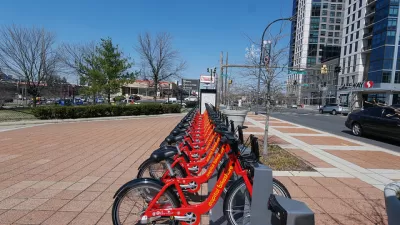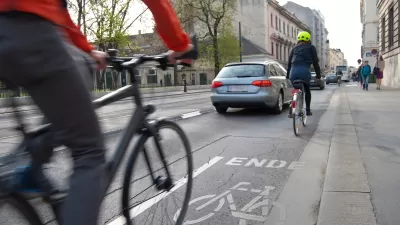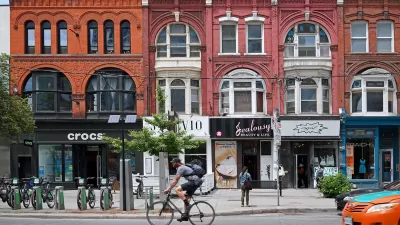Just to the north of Washington D.C., Montgomery County will soon begin an update to its Bicycle Master Plan in the hopes of taking advantage of the evolving world of alternative transportation.
Sean Emerson makes a persuasive and passionate argument on the Around the Corners blog about the importance of the ongoing Bicycle Master Plan update process in Montgomery County. The process officially launches on July 1, and, according to Emerson, "will focus on evaluating new facilities such as buffered bike lanes, bike boulevards, and secure bicycle storage facilities."
Emerson explains that Montgomery County last updated its bicycle master plan in 2005 and notes that the county already has some ambitious projects on the planning books that have yet to come to fruition. Yet, says Emerson, "[t]he Bicycle Master Plan update is our chance to demand adequate bike facilities." He goes on to list a wish-list of desired projects like buffered bike paths and bike and pedestrian bridges at specific locations.
In other recent coverage of the bike planning process, Aaron Kraut reports that "[Montgomery County planners] will create a bicycle 'stress map' on which every street in Montgomery County will be assessed in terms of how stressful it is to bicyclists." The stress map methodology is the result of a 2012 study by San Jose State University’s Mineta Transportation Institute.
Kate S. Alexander covered the announcement of the bike planning process in April 2015. According to Alexander's coverage, the planning process will focus "on developing a bicycle network aimed at providing access to future Corridor Cities Transitway stations and coordinating with the Life Science Center Loop, an off-road trail being designed by the planning department."
FULL STORY: Bicycle Master Plan update is an opportunity for Four Corners

Study: Maui’s Plan to Convert Vacation Rentals to Long-Term Housing Could Cause Nearly $1 Billion Economic Loss
The plan would reduce visitor accommodation by 25,% resulting in 1,900 jobs lost.

North Texas Transit Leaders Tout Benefits of TOD for Growing Region
At a summit focused on transit-oriented development, policymakers discussed how North Texas’ expanded light rail system can serve as a tool for economic growth.

Using Old Oil and Gas Wells for Green Energy Storage
Penn State researchers have found that repurposing abandoned oil and gas wells for geothermal-assisted compressed-air energy storage can boost efficiency, reduce environmental risks, and support clean energy and job transitions.

Private Donations Propel Early Restoration of Palisades Playground
Los Angeles has secured over $1.3 million in private funding to restore the Pacific Palisades playground months ahead of schedule, creating a modern, accessible space that supports community healing after recent wildfires.

From Blight to Benefit: Early Results From California’s Equitable Cleanup Program
The Equitable Community Revitalization Grant (ECRG) program is reshaping brownfield redevelopment by prioritizing projects in low-income and environmental justice communities, emphasizing equity, transparency, and community benefits.

Planting Relief: Tackling Las Vegas Heat One Tree at a Time
Nevada Plants, a Las Vegas-based nonprofit, is combating the city’s extreme urban heat by giving away trees to residents in underserved neighborhoods, promoting shade, sustainability, and community health.
Urban Design for Planners 1: Software Tools
This six-course series explores essential urban design concepts using open source software and equips planners with the tools they need to participate fully in the urban design process.
Planning for Universal Design
Learn the tools for implementing Universal Design in planning regulations.
Ascent Environmental
Borough of Carlisle
Institute for Housing and Urban Development Studies (IHS)
City of Grandview
Harvard GSD Executive Education
Toledo-Lucas County Plan Commissions
Salt Lake City
NYU Wagner Graduate School of Public Service





























